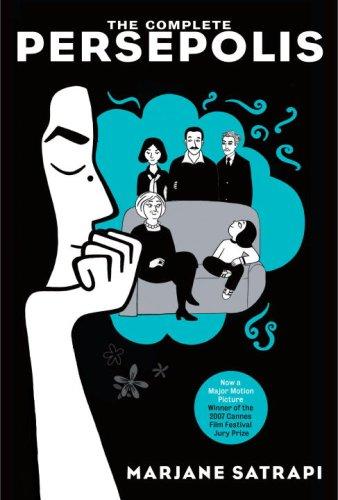The Complete Persepolis is the autobiography of a girl growing up in Iran, during the Iranian revolution, 1979. Unlike other novels I've read, it's a graphic novel; this means it mostly exists out of illustrations and has some narration and/or speech bubbles. For the reader, this means there's little room for their own imagination and fantasy, as the scene is already drawn.
The illustrations are made by differences between black and white contrast, creating figures and objects. This limits the illustrator's options in colour, as the only two "colours" available are black and white. I think the illustrator has done a great job of portraying the life experiences of Marjane, by using contrast only.
Throughout Marjane's life and thus throughout this autobiography, various topics come to order. This includes the strict Islamic Sharia laws, the identity struggle between Western and the more conservative and Islamic life of Marjane, and some more sensitive topics, such as child soldiers, rape, torture, and (mass) murder are discussed in this novel. It's fascinating to see how a child processes and handles the possession of knowing these R-rated topics. Occasionally there are some swearing words, which surprised me . I didn't expect swear words to appear in this novel, but since there are some other adult topics being discussed, I guess I shouldn't be surprised at adult vocabulary being used.
The book follows a chronological order, meaning the protagonist is a child in the beginning, and an adult at the end. This also makes it a "coming of age" novel, where the main character grows up and comes of age. Normally I'm not into these kind of books, however Satrapi's life is exceptional, and she has experienced things no child should've experienced. Therefore I feel like this novel has a convoluted story with complicated characters and therefore an interesting read.
The novel heavily discusses the topics about the Islam, the revolution itself, the stereotypes about Iran, integration into the Western culture, and last but not least, the identity crisis.
Satrapi has written this book because she wanted to let people know that humans are the same. No matter what culture, what background, what origins someone has, they are still human and make human mistakes. I think she has successfully gotten this message across to the reader, as I (and other readers) have seen and read how Marjane and her (childhood) friends behave the same as any other people in the West. They play, they laugh, they fight, they do anything people do in the Western culture, and more. This contradicts the popular stereotypes about Iran, where people think Iran is "a terrible place to live in".
Additionally, the book discusses identity. When Marjane moves to Austria, to live with her parents' friend, she gets to know the Western culture and lifestyle. This causes her to slowly integrate into the Western society. During her stay in Austria, she discovers the ideas about Iran people have, and starts to feel ashamed of her origin. She starts telling people she's actually from France, and she tells her first boyfriend she's from France as well. By doing this, she renounces her identity. This leads to an interesting series of events, where she feels like she doesn't belong anywhere.
In my opinion, anyone who wants to know more about the Islam, Iran, identity, Iranian revolution, or Marjane Satrapi as a person, should read this book. It contains a lot of information and details about the daily life before and after the revolution in Iran, and it shows that people in Iran are just like the people in the West. To conclude, I would give this a 5/5, as I found it very interesting to read.










